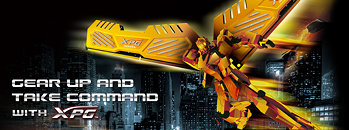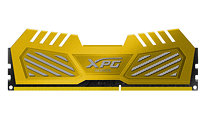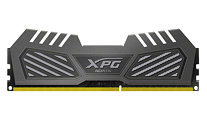Monday, July 29th 2013

ADATA Launches Newest XPG V2 3100 Overclocking Memory
ADATA Technology, a leading manufacturer of high-performance DRAM modules and NAND Flash application products, announced today the launch of the latest XPG V2 series overclocking memory, running at a stellar 3100 megahertz. This new product's dual channel is designed to bring ultimate performance to gamers using Intel Core fourth-generation processors and the latest Z87 platform.
The XPG 3100 V2 is the result of special cooperation with Asrock, and suitable for all motherboards that employ the enthusiast oriented Z87 chipset. Due to strict compatibility testing and QVL (Qualified Vendor List) certification, the modules can be directly overclocked using XMP (EXtreme Memory Profile) to the highest frequency of 3100Mhz. This unprecedented speed will gratify those who always seek an edge in boosting system performance.The new XPG V2 product specifically targets the world's gamers with unmatched speed and unique cooling efficiency, fully meeting the specific needs that arise from overclocked performance. Not only can speeds of 3100MHz be reached, but bandwidth can attain rates of up to 24,800MB/second, once again breaking through top performance levels for overclocking memory.
Product Features
The XPG 3100 V2 is the result of special cooperation with Asrock, and suitable for all motherboards that employ the enthusiast oriented Z87 chipset. Due to strict compatibility testing and QVL (Qualified Vendor List) certification, the modules can be directly overclocked using XMP (EXtreme Memory Profile) to the highest frequency of 3100Mhz. This unprecedented speed will gratify those who always seek an edge in boosting system performance.The new XPG V2 product specifically targets the world's gamers with unmatched speed and unique cooling efficiency, fully meeting the specific needs that arise from overclocked performance. Not only can speeds of 3100MHz be reached, but bandwidth can attain rates of up to 24,800MB/second, once again breaking through top performance levels for overclocking memory.
Product Features
- Supports Intel XMP (Extreme Memory Profiles) version 1.3
- Supports dual channel mode
- RoHS compliant
- Complies with JEDEC standards.
- Uses high-quality 8-layer printed circuit boards and aluminum heat sink, effectively reducing the memory module temperature
- Adopts Thermal Conductive Technology (TCT) thermal technology for heat dispersal
- Supports Intel Core processors and the latest fourth-generation Z87 platform
- Model: XPG V2 DDR3 3100
- Timing: DDR3 1333 CL9-9-9-24 at 1.5V & DDR3 3100 CL12-14-14-36 at 1.65V (XMP Profile 1)
- Density: 8GB (4GB x 2)
- Frequency (Peak transfer rate): 3100MHz (24,800MB/sec)
- Voltage: 1.65 Volts



19 Comments on ADATA Launches Newest XPG V2 3100 Overclocking Memory
Single Sided Hynix MFR does not equal anything performance. This is from another review at TPU, also with single sided MFR. Draw your own conclusions.
www.computing.net/answers/hardware/double-vs-single-sided-ram-/67771.html
The performance deficit is mainly related to Rank Interleaving, and the high RTLs won't help either. It's quite simple really; single sided DDR3-3000 is slower than dual sided DDR3-2133C11. Doesn't matter what platform.
:laugh:
If you run the same DDR3-2933 kit @ 2600 bandwith will be better, so for me it's related to the IMC configuration and not the DDR3 itself.
Now when you start talking about paying $300-$400 for a 2800 kit of G.Skill 2 x 4GB, I agree, it's a complete waste of $ when you consider the upgrades that money could have got you, such as a much better video card. But remember, these kits are aimed at the people who already have the best hardware and are looking for that last little bit of performance.
I believe that there's a sweet spot for RAM price/performance ratio for any point in time. 7 months ago, it seemed to be 2133 kits, now 2400 may be the new sweet spot. Performance is performance, just because all RAM is so fast it's hard to tell the difference doesn't mean there's no difference. If most of what you do is gaming, the performance won't matter. For those of us who use our PCs for more CPU/RAM intensive tasks, it certainly DOES matter.